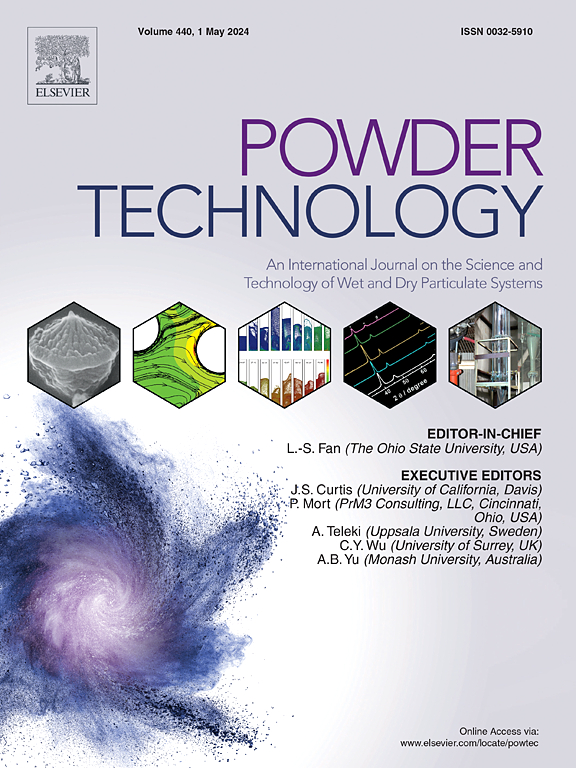火花等离子烧结的热电耦合离散元模型
IF 4.5
2区 工程技术
Q2 ENGINEERING, CHEMICAL
引用次数: 0
摘要
火花等离子烧结(SPS)是一种新兴的粉末固化技术,它利用电流通过焦耳效应产生热量,同时施加压力以有效地实现致密化。在这个过程中一个常见的问题是焦耳热的局部化在粒子之间的接触,那里的电阻是最高的。本文采用原始离散元模型(DEM)研究了烧结材料中的热电耦合现象。该模型采用两颗粒烧结几何形状,颗粒通过颈部相互连接。颈部尺寸使用体积保存标准进行评估,并引入了补偿非物理重叠以及附加晶界阻力的校正因子。通过与有限元模拟的对比,验证了DEM模型的正确性。一个简单的三粒子几何被用来证明,简单的DEM模型给出了相同的电位演变,合成电流和温度演变作为更复杂的有限元模型。然后,根据实际粒度分布生成的几何图形对DEM模型进行验证,以保证微观结构的非均匀性。分析了密度对电势演变、焦耳加热和由此引起的温度升高的影响。结果表明,焦耳热集中在较小的颗粒中,并传导到整个样品中,导致温度均匀升高。最后,分析了致密化对升温速率的影响。这项研究提高了对SPS过程中热电行为的整体理解,为微观现象提供了重要的见解。本文章由计算机程序翻译,如有差异,请以英文原文为准。

Coupled thermo-electric discrete element model for spark plasma sintering
Spark Plasma Sintering (SPS) is an emerging powder consolidation technique that employs electric current to generate heat through the Joule effect while applying pressure to achieve densification efficiently. A common concern in this process is the localization of Joule heat at the contacts between particles where electrical resistance is highest. This study investigates the coupled thermo-electric phenomena in sintered material using an original discrete element model (DEM). The model employs a two-particle sintering geometry, with particles interconnected by the neck. Neck size is evaluated using volume preservation criteria, and a correction factor compensating for non-physical overlaps as well as additional grain boundary resistance is introduced. The DEM model is verified by comparing with FEM simulations. A simple three-particle geometry is used to demonstrate that the simple DEM model gives the same potential evolution, resultant currents and temperature evolution as the more complex finite element model. Thereafter, the DEM model is validated on geometry generated using real particle size distribution to ensure heterogeneous microstructure. The effect of density on the electrical potential evolution, Joule heating and resulting increase in temperature is analysed. It is shown that the Joule heat is concentrated in the smaller particles and is conducted throughout the sample, resulting in a homogeneous increase in temperature. Ultimately, the effect of densification on heating rate is analysed. This study improves the overall understanding of thermo-electric behaviour in the SPS process, providing significant insights into the microscopic phenomena.
求助全文
通过发布文献求助,成功后即可免费获取论文全文。
去求助
来源期刊

Powder Technology
工程技术-工程:化工
CiteScore
9.90
自引率
15.40%
发文量
1047
审稿时长
46 days
期刊介绍:
Powder Technology is an International Journal on the Science and Technology of Wet and Dry Particulate Systems. Powder Technology publishes papers on all aspects of the formation of particles and their characterisation and on the study of systems containing particulate solids. No limitation is imposed on the size of the particles, which may range from nanometre scale, as in pigments or aerosols, to that of mined or quarried materials. The following list of topics is not intended to be comprehensive, but rather to indicate typical subjects which fall within the scope of the journal's interests:
Formation and synthesis of particles by precipitation and other methods.
Modification of particles by agglomeration, coating, comminution and attrition.
Characterisation of the size, shape, surface area, pore structure and strength of particles and agglomerates (including the origins and effects of inter particle forces).
Packing, failure, flow and permeability of assemblies of particles.
Particle-particle interactions and suspension rheology.
Handling and processing operations such as slurry flow, fluidization, pneumatic conveying.
Interactions between particles and their environment, including delivery of particulate products to the body.
Applications of particle technology in production of pharmaceuticals, chemicals, foods, pigments, structural, and functional materials and in environmental and energy related matters.
For materials-oriented contributions we are looking for articles revealing the effect of particle/powder characteristics (size, morphology and composition, in that order) on material performance or functionality and, ideally, comparison to any industrial standard.
 求助内容:
求助内容: 应助结果提醒方式:
应助结果提醒方式:


